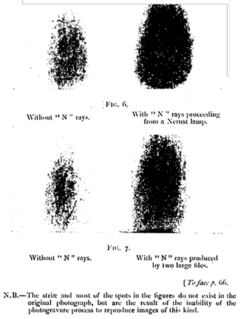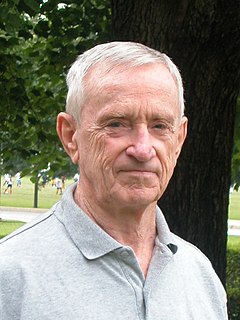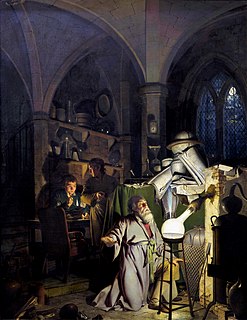
Homeopathy or homoeopathy is a pseudoscientific system of alternative medicine. Its practitioners, called homeopaths, believe that a substance that causes symptoms of a disease in healthy people can cure similar symptoms in sick people; this doctrine is called similia similibus curentur, or "like cures like". All relevant scientific knowledge about physics, chemistry, biochemistry and biology contradicts homeopathy. Homeopathic remedies are typically biochemically inert, and have no effect on any known disease. Its theory of disease, centered around principles Hahnemann termed miasms, is inconsistent with subsequent identification of viruses and bacteria as causes of disease. Clinical trials have been conducted and generally demonstrated no objective effect from homeopathic preparations. The fundamental implausibility of homeopathy as well as a lack of demonstrable effectiveness has led to it being characterized within the scientific and medical communities as quackery and fraud.
The expression junk science is used to describe scientific data, research, or analysis considered by the person using the phrase to be spurious or fraudulent. The concept is often invoked in political and legal contexts where facts and scientific results have a great amount of weight in making a determination. It usually conveys a pejorative connotation that the research has been untowardly driven by political, ideological, financial, or otherwise unscientific motives.

N-rays were a hypothesized form of radiation, described by French physicist Prosper-René Blondlot in 1903, and initially confirmed by others, but subsequently found to be illusory.

Pseudoscience consists of statements, beliefs, or practices that claim to be both scientific and factual but are incompatible with the scientific method. Pseudoscience is often characterized by contradictory, exaggerated or unfalsifiable claims; reliance on confirmation bias rather than rigorous attempts at refutation; lack of openness to evaluation by other experts; absence of systematic practices when developing hypotheses; and continued adherence long after the pseudoscientific hypotheses have been experimentally discredited.
Pathological science is an area of research where "people are tricked into false results ... by subjective effects, wishful thinking or threshold interactions." The term was first used by Irving Langmuir, Nobel Prize-winning chemist, during a 1953 colloquium at the Knolls Research Laboratory. Langmuir said a pathological science is an area of research that simply will not "go away"—long after it was given up on as "false" by the majority of scientists in the field. He called pathological science "the science of things that aren't so."

The Skeptic's Dictionary is a collection of cross-referenced skeptical essays by Robert Todd Carroll, published on his website skepdic.com and in a printed book. The skepdic.com site was launched in 1994 and the book was published in 2003 with nearly 400 entries. As of January 2011 the website has over 700 entries. A comprehensive single-volume guides to skeptical information on pseudoscientific, paranormal, and occult topics, the bibliography contains some seven hundred references for more detailed information. According to the back cover of the book, the on-line version receives approximately 500,000 hits per month.
Brilliant Light Power, Inc. (BLP), formerly BlackLight Power, Inc. of Cranbury, New Jersey, is a company founded by Randell L. Mills, who claims to have discovered a new energy source from observing that electron in a hydrogen atom can drop below the lowest energy state into a "hydrino state". The claims lack corroborating scientific evidence despite claims of experimental verification, and the proposed hydrino states are unphysical and incompatible with key equations of Quantum Mechanics. BLP has announced several times that it was about to deliver commercial products based on Mill's theories but is yet to deliver a working product.
Fringe science refers to ideas whose attributes include being highly speculative or relying on premises already refuted. Fringe science theories are often advanced by persons who have no traditional academic science background, or by researchers outside the mainstream discipline. The general public has difficulty distinguishing between science and its imitators, and in some cases a "yearning to believe or a generalized suspicion of experts is a very potent incentive to accepting pseudoscientific claims".

Robert Lee Park was an American emeritus professor of physics at the University of Maryland, College Park, and a former director of public information at the Washington office of the American Physical Society. Park was most noted for his critical commentaries on alternative medicine and pseudoscience, as well as his criticism of how legitimate science is distorted or ignored by the media, some scientists, and public policy advocates as expressed in his book Voodoo Science. He was also noted for his preference for robotic over manned space exploration.

Luc Montagnier was a French virologist and joint recipient, with Françoise Barré-Sinoussi and Harald zur Hausen, of the 2008 Nobel Prize in Physiology or Medicine for his discovery of the human immunodeficiency virus (HIV). He worked as a researcher at the Pasteur Institute in Paris and as a full-time professor at Shanghai Jiao Tong University in China.
Dean Radin investigates phenomena in parapsychology. Following a bachelor and master's degree in electrical engineering and a PhD in educational psychology Radin worked at Bell Labs, researched at Princeton University, GTE Laboratories, University of Edinburgh, SRI International, Interval Research Corporation, and was a faculty member at University of Nevada, Las Vegas. Radin then became Chief Scientist at the Institute of Noetic Sciences (IONS), in Petaluma, California, USA. Radin served on dissertation committees at Saybrook Graduate School and Research Center, and was former President of the Parapsychological Association. He is also co-editor-in-chief of the journal Explore: The Journal of Science and Healing.

Water memory is the purported ability of water to retain a memory of substances previously dissolved in it even after an arbitrary number of serial dilutions. It has been claimed to be a mechanism by which homeopathic remedies work, even when they are diluted to the point that no molecule of the original substance remains, but has no scientific proof.

The history of pseudoscience is the study of pseudoscientific theories over time. A pseudoscience is a set of ideas that presents itself as science, while it does not meet the criteria to properly be called such.

Oscillococcinum is a homeopathic preparation marketed to relieve flu-like symptoms, although it does not provide any benefit beyond that of a placebo.

Nicholas Michael Landon Wade is a British author and journalist. He is the author of numerous books, and has served as staff writer and editor for Nature, Science, and the science section of The New York Times.
The Patterson power cell is an electrolysis device invented by chemist James A. Patterson, which he said created 200 times more energy than it used, and neutralize radioactivity without emitting any harmful radiation. It is one of several cells that some observers classified as cold fusion; cells which were the subject of an intense scientific controversy in 1989, before being discredited in the eyes of mainstream science.
The Hongcheng Magic Liquid incident was a scam in China where Wang Hongcheng, a bus driver from Harbin with no scientific education, claimed in 1983 that he could turn regular water into a fuel as flammable as petrol by simply dissolving a few drops of his liquid in it. He founded the Hongcheng Magic Liquid company with funds from Chinese governmental agencies and other supporters, raising a total of 300 million yuan, but no product was ever released.
Microwave News reports on the health and environmental impacts of electromagnetic fields (EMFs) and other types of non-ionizing radiation, with special emphasis on cell phones and power lines. It also covers radar, radio and TV broadcast towers and many related topics. Its headquarters is in New York City.
Homeopathy is a peer-reviewed medical journal covering research, reviews, and debates on all aspects of homeopathy, a pseudoscientific form of alternative medicine. It is the official journal of the London-based Faculty of Homeopathy. The journal was established in 1911 as the British Homoeopathic Journal, resulting from a merger between the British Homoeopathic Review and the Journal of the British Homoeopathic Society. It obtained its current name in 2001 and the Editor-in-chief is Dr Robert Mathie. The journal was originally published by Nature Publishing Group, and was then published by Elsevier. Elsevier's decision to publish this journal has been called into question, given homeopathy's proven ineffectiveness and unscientific status. Elsevier's Vice President of Global Corporate Relations, Thomas Reller, has defended Elsevier's decision to publish the journal, saying that "We support debate around this topic". The journal has been published by Thieme Medical Publishers since 2018.










